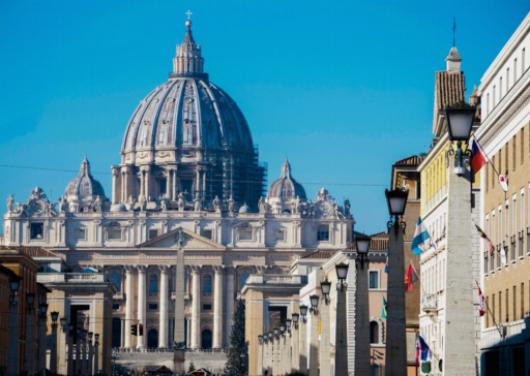Vatican City, known for its rich history and stunning architecture, is home to the famous St. Peter's Basilica. This iconic structure has been shaped and influenced by some of the most renowned artists and architects in history. From Gian Lorenzo Bernini's exquisite sculptures to Carlo Maderno's role in the basilica's construction, each individual's contributions have left a lasting impact on this revered religious site. The blend of Baroque art and architecture within St. Peter's Basilica showcases a harmonious fusion of creativity and craftsmanship, making it a must-see destination for travelers and art enthusiasts alike.

Gian Lorenzo Bernini's Sculptures in St. Peter's Basilica
Gian Lorenzo Bernini, one of the most renowned sculptors of his time, made significant contributions to the beautification of St. Peter's Basilica in Rome. His masterful sculptures can be found throughout the basilica, each showcasing his incredible talent and skill.
One of Bernini's most famous works in St. Peter's Basilica is the Baldachin, a large bronze canopy located directly above the high altar. This monumental piece serves as a focal point in the basilica and is known for its intricate details and impressive size. Bernini also created the Cathedra Petri, or Chair of St. Peter, located in the apse of the basilica. This sculpture, with its dynamic composition and dramatic lighting, symbolizes the authority of the papacy.
Additionally, Bernini was responsible for the creation of the monument to Pope Alexander VII, which features a lifelike portrait of the pope surrounded by allegorical figures. This sculpture is a testament to Bernini's ability to capture both the physical likeness and the spiritual essence of his subjects.
Overall, Gian Lorenzo Bernini's sculptures in St. Peter's Basilica not only enhance the beauty of the church, but also serve as a lasting tribute to his artistic genius and creativity.
The Role of Carlo Maderno in the Construction of St. Peter's Basilica
Carlo Maderno played a significant role in the construction of St. Peter's Basilica in Rome. Maderno was an Italian architect who was entrusted with the task of completing the construction of the basilica after the death of the original architect, Michelangelo. One of Maderno's most notable contributions to the basilica was the extension of the nave, creating a grand entrance for visitors.
Maderno's design for the space was crucial in providing a sense of awe and grandeur for those entering the basilica. His use of classical elements, such as columns and pilasters, added a sense of gravitas to the entrance, drawing visitors in and preparing them for the breathtaking interior that awaited them.
Additionally, Maderno's design for the facade of the basilica is considered one of the most important elements of the building. The facade, with its central balcony and two bell towers, is a striking example of Baroque architecture and a testament to Maderno's skill as an architect.
Overall, Carlo Maderno's contributions to the construction of St. Peter's Basilica were essential in creating the masterpiece that stands today as one of the most important religious buildings in the world. His innovative designs and attention to detail have left a lasting impact on the architecture of the basilica and continue to inspire visitors from around the globe.
Raphael's Influence on the Interior Decor of St. Peter's Basilica
Raphael, one of the greatest artists of the Italian Renaissance, played a significant role in influencing the interior decor of St. Peter's Basilica. His work in the Vatican, particularly in the Stanze di Raffaello, showcased his mastery of fresco painting and classical motifs. This influence can be seen in the use of harmonious colors, intricate details, and a sense of balance and proportion in the design of the interior spaces of St. Peter's Basilica. Raphael's work added a sense of refinement and elegance to the overall aesthetic of the basilica, contributing to its status as a masterpiece of Renaissance art and architecture.
Baroque Art and Architecture in St. Peter's Basilica
Baroque art and architecture in St. Peter's Basilica encompasses some of the most important works by renowned artists and architects of the period. The lavish decoration and grandeur of the basilica reflect the Baroque style, characterized by its extravagant details, dramatic lighting effects, and emotional intensity.
One of the most prominent examples of Baroque art in St. Peter's Basilica is Gian Lorenzo Bernini's Baldacchino, a monumental bronze canopy located above the high altar. The intricately designed canopy serves as a focal point of the basilica, standing at over 29 meters high and adorned with elaborate ornamentation and sculptural elements. Bernini's sculptural genius is further showcased in his St. Longinus and St. Veronica statues, which flank the central nave and add to the overall grandeur of the space.
Carlo Maderno, the architect responsible for the basilica's façade, also played a crucial role in shaping the Baroque style of St. Peter's. His design combined classical elements with Baroque details, resulting in a façade that exudes both grandeur and harmony. The balanced proportions and intricate details of the façade reflect the Baroque emphasis on theatricality and illusion.
Raphael's influence can be seen in the interior decor of St. Peter's Basilica, particularly in the design of the mosaics and frescoes adorning the walls and ceilings. The use of vibrant colors, elaborate ornamentation, and dynamic compositions in these works exemplifies the Baroque aesthetic and adds to the overall opulence of the basilica.
Overall, the Baroque art and architecture in St. Peter's Basilica are a testament to the creativity and skill of the artists and architects involved in its construction. The lavish decoration, dramatic lighting effects, and emotional intensity of the Baroque style contribute to the awe-inspiring beauty of this iconic religious site.
